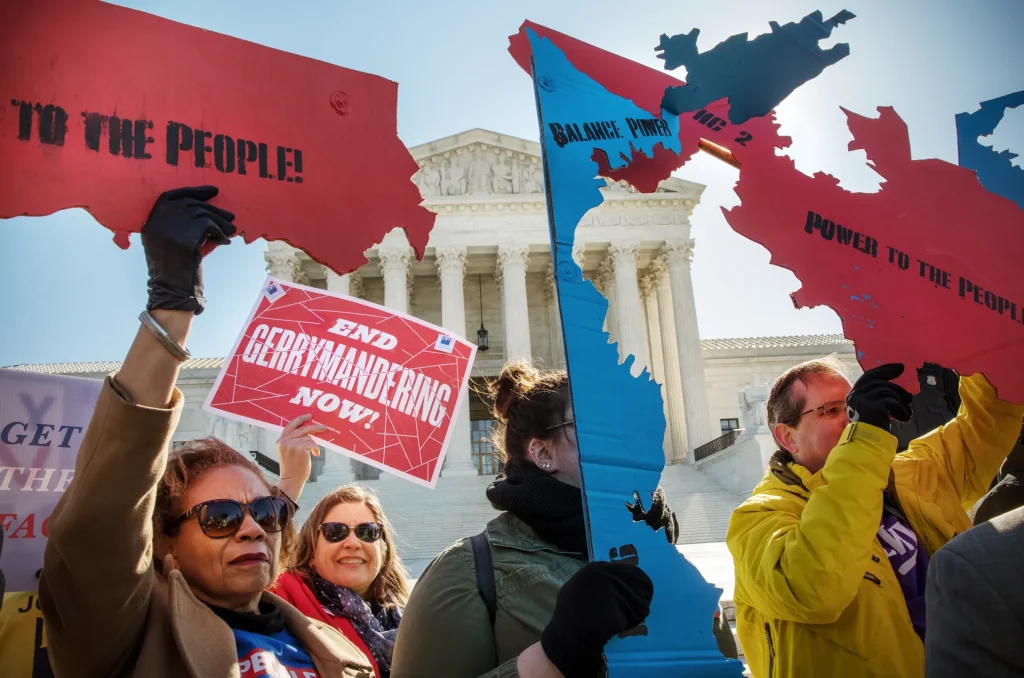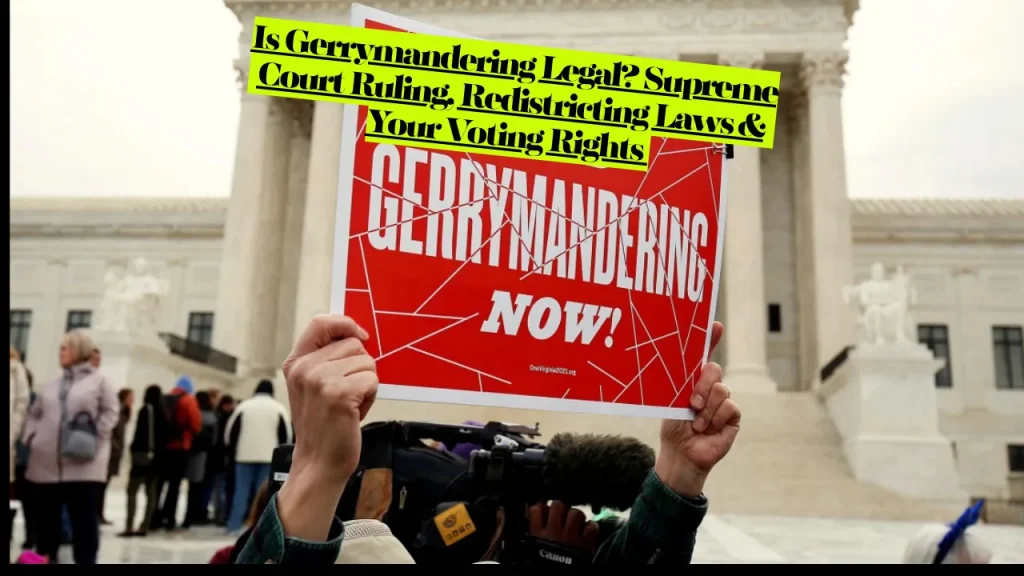Is Gerrymandering Legal? Supreme Court Ruling, Redistricting Laws & Your Voting Rights
Partisan gerrymandering is largely legal after the Supreme Court’s 2019 Rucho v. Common Cause decision declared such claims beyond federal court jurisdiction. Racial gerrymandering remains illegal under the Voting Rights Act and Fourteenth Amendment. This constitutional split creates a complex legal landscape where politicians can draw districts favoring their party, but cannot draw maps primarily based on race.
The distinction matters because your representation in Congress depends on district boundaries redrawn every decade. Recent mid-decade redistricting efforts in multiple states have intensified debates about gerrymandering legality and voting rights.
What Makes Gerrymandering Legal or Illegal?
The Supreme Court ruled that federal courts lack judicially manageable standards to determine when partisan gerrymandering becomes unconstitutional. Chief Justice Roberts explained that while partisan gerrymandering may be “incompatible with democratic principles,” no clear constitutional benchmark exists for judges to apply.
Racial gerrymandering faces strict scrutiny when race is the predominant factor in drawing district lines. Courts must determine whether the map serves a compelling government interest using the narrowest means possible.
Partisan vs. Racial Gerrymandering: The Legal Dividing Line
Partisan gerrymandering (legal):
- Districts drawn to favor Republican or Democratic candidates
- Based on political affiliation and voting patterns
- Federal courts cannot review these claims after Rucho
- State courts may still intervene under state constitutions
Racial gerrymandering (illegal):
- Districts drawn predominantly to segregate voters by race
- Violates Equal Protection Clause when race is controlling factor
- Subject to Section 2 of the Voting Rights Act prohibiting vote dilution
Related article: Are FRT Triggers Legal? ATF Ruling, Court Battles & State-by-State Ban Status

How Rucho v. Common Cause Changed Everything
North Carolina legislators explicitly instructed mapmakers to create a plan producing ten Republican and three Democratic seats. Lower courts struck down this map as unconstitutional partisan gerrymandering.
The Supreme Court’s 5-4 decision reversed these rulings, holding that partisan gerrymandering claims present nonjusticiable political questions beyond federal court reach. Justice Roberts wrote that no legal standards exist in the Constitution for making such judgments.
Justice Elena Kagan’s dissent warned the ruling would imperil democracy’s foundations by allowing lawmakers to choose their voters instead of voters choosing representatives.
What This Means for Your Congressional District
Federal courts cannot stop even extreme partisan gerrymandering. Common Cause and other advocates shifted focus to state-level redistricting reforms following the Rucho decision.
State courts operating under state constitutions retain jurisdiction over partisan gerrymandering claims—creating a patchwork of protections varying dramatically by location.
Voting Rights Act: The Racial Gerrymandering Firewall
The Supreme Court’s 2023 Allen v. Milligan decision reaffirmed Section 2 of the Voting Rights Act, requiring Alabama to create a second majority-Black congressional district.
Section 2 prohibits voting procedures that result in denial or curtailment of voting rights based on race or color. This applies regardless of legislative intent—discriminatory results alone violate the law.
The Gingles Test for Vote Dilution
Courts apply three preconditions from Thornburg v. Gingles (1986) to evaluate racial gerrymandering claims:
- The minority group must be sufficiently large and geographically compact to constitute a majority in a district
- The minority group must be politically cohesive
- White majority voters must consistently defeat minority-preferred candidates
In Alabama, Black voters supported their preferred candidates with 92.3% of votes while white voters supported Black-preferred candidates only 15.4% of the time.
Cracking and Packing: Illegal Tactics
“Cracking” divides minority communities across multiple districts to dilute their voting power, while “packing” concentrates minorities into few districts to minimize their influence elsewhere.
Alabama initially defied court orders by submitting a 2023 map with only one majority-Black district, prompting additional litigation and court-ordered remedial maps.
State-by-State Redistricting Standards
Twenty-one states use some form of redistricting commission, with thirteen using commissions exclusively for drawing electoral boundaries.
States With Independent Redistricting Commissions
States with independent commissions preventing politician control of mapmaking:
- Arizona: 14-member commission validated by Arizona State Legislature v. Arizona Independent Redistricting Commission (2015)
- California: 14-member Citizens Redistricting Commission
- Colorado: Separate 12-member commissions for congressional and state legislative districts
- Michigan: 13-member commission with equal partisan balance
- Washington: 5-member bipartisan commission
California recently established independent commissions at the county level, including San Luis Obispo County in September 2024.
States Where Legislatures Control Redistricting
Most states allow legislatures to draw district maps—creating opportunities for the party in power to entrench electoral advantages through gerrymandering.
Recent attempts to bypass independent commissions for mid-decade redistricting have emerged in multiple states responding to political pressure.

Recent Court Decisions Reshaping Redistricting Law
Alabama’s Continued Defiance
A May 2025 federal court ruling found Alabama’s 2023 congressional map both violated Section 2 and was enacted with racially discriminatory intent—one of the strongest rebukes of redistricting practices in recent years.
Louisiana and the Future of Section 2
The Supreme Court ordered reargument in Louisiana’s redistricting case, signaling potential reconsideration of Section 2’s scope. Chief Justice Roberts reportedly negotiated with Justice Kavanaugh to form the narrow 5-4 majority preserving Section 2 in Allen v. Milligan.
Voting rights advocates fear the conservative majority may limit Section 2 protections despite the 2023 Milligan victory.
State Court Victories
Georgia courts required creation of at least six new majority-Black state legislative districts following successful Section 2 litigation.
As of October 2025, live litigation challenges to congressional or state legislative lines continue in 14 states.
What Voters Can Do About Gerrymandering
Support Redistricting Reform
The Redistricting Reform Act of 2025 would require all states to establish independent redistricting commissions and prohibit mid-decade redistricting. The legislation has Democratic sponsorship but lacks Republican support.
Ohio voters rejected a 2024 constitutional amendment that would have established citizen-led redistricting commissions, showing reform faces mixed public reception.
Challenge Illegal Maps in State Courts
Federal courts cannot address partisan gerrymandering, but state courts applying state constitutional provisions may provide relief.
Recent successful challenges include:
- North Carolina state courts invalidating gerrymandered maps
- Arizona courts striking down districts that circumvented independent redistricting commissions
Monitor Your District’s Demographics
Section 2 claims require showing minority communities can elect candidates of choice in properly drawn districts. Engage with redistricting processes during census years and provide testimony about community boundaries.
The Race vs. Party Dilemma
Courts face the cumbersome task of disentangling race from party in hyperpolarized environments where racial and partisan affiliation closely correlate.
After Rucho declared partisan gerrymandering nonjusticiable while racial gerrymandering remains illegal, defendants in racial gerrymandering cases increasingly invoke partisanship as justification for contested maps.
The Alexander v. South Carolina case required the Supreme Court to clarify how judges distinguish whether race or party drove redistricting decisions.
Looking Ahead: 2030 Census and Beyond
The next census triggers comprehensive redistricting nationwide. Current legal standards will shape congressional representation through 2032.
Advocates continue pushing for universal independent redistricting commissions through state legislation and ballot initiatives.
The conservative Supreme Court majority’s moves on race-related issues including voting suggest potential future restrictions on even racial gerrymandering protections.
Frequently Asked Questions
Is gerrymandering legal in the United States?
Partisan gerrymandering is legal because federal courts cannot review such claims after Rucho v. Common Cause (2019). Racial gerrymandering remains illegal when race predominates in drawing district lines under the Equal Protection Clause and Voting Rights Act.
Can courts still stop gerrymandering?
Yes, but jurisdiction depends on the type. Federal courts can strike down racial gerrymandering under the Voting Rights Act. State courts may address partisan gerrymandering under state constitutional provisions. Federal courts have no jurisdiction over partisan gerrymandering claims.
What did the Supreme Court rule about gerrymandering?
The Supreme Court ruled in Rucho v. Common Cause that partisan gerrymandering claims present political questions beyond federal court jurisdiction because no judicially manageable standards exist. The Court reaffirmed racial gerrymandering protections in Allen v. Milligan (2023).
How do independent redistricting commissions work?
Independent commissions are composed of citizens who cannot hold political office, with most states requiring equal partisan representation. The Supreme Court validated their constitutionality in Arizona State Legislature v. Arizona Independent Redistricting Commission (2015).
What is the difference between cracking and packing?
Cracking divides minority voters among multiple districts to prevent them from constituting majorities, while packing concentrates minorities into few districts to limit their influence across other districts. Both tactics can violate the Voting Rights Act.
Can states redraw districts between census years?
Yes. Multiple states have pursued mid-decade redistricting in 2025 despite traditional practice of redistricting only after census counts. Proposed federal legislation would prohibit this practice.
Who draws congressional district maps?
Eleven states use commissions for congressional redistricting, while most states assign this power to state legislatures. Iowa uses a unique nonpartisan process involving neither legislature nor independent commission.
Disclaimer: This information is for educational purposes only and does not constitute legal advice. Consult an attorney specializing in election law or your specific jurisdiction for legal guidance on redistricting issues affecting your area.
Internal Resources:
External Resources:
About the Author

Sarah Klein, JD, is a licensed attorney and legal content strategist with over 12 years of experience across civil, criminal, family, and regulatory law. At All About Lawyer, she covers a wide range of legal topics — from high-profile lawsuits and courtroom stories to state traffic laws and everyday legal questions — all with a focus on accuracy, clarity, and public understanding.
Her writing blends real legal insight with plain-English explanations, helping readers stay informed and legally aware.
Read more about Sarah
